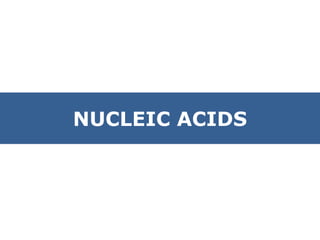07 nucleic acids
- 2. WHAT ARE NUCLEIC ACIDS? âĒ Used for: âĒ Storing genetic information âĒ Assembly instructions for protein synthesis âĒ Energy molecule (ATP â adenosine triphosphate) âĒ Two major nucleic acid polymers: âĒ DNA: deoxyribonucleic acid âĒ RNA: ribonucleic acid
- 3. NUCLEIC ACIDS DNA RNA - Located in the nucleus - Located mostly in the cytoplasm - Double-stranded, double helix structure - Single-stranded structure - Stable molecule - Less stable molecule
- 4. NUCLEOTIDES âĒ Monomer of nucleic acids âĒ Three components: 1. Phosphate 2. Pentose sugar 3. Nitrogenous base
- 5. NUCLEOSIDE
- 7. NITROGENOUS BASES Purines Pyrimidines RNA DNA
- 8. PHOSPHODIESTER BOND âĒ Phosphodiester bond formed between nucleotides: âĒ Pentose sugar (-OH group) âĒ Phosphate group
- 9. âBACKBONEâ OF DNA âĒ Linking nucleotides produces a single strand of DNA âĒ Phosphate + deoxyribose = backbone
- 10. COMPLIMENTARY BASE PAIRING âĒ Nitrogenous bases are joined through Hydrogen bonding âĒ Complimentary base pairs: âĒ Adenine + Thymine âĒ 2 H bonds âĒ Cytosine + Guanine âĒ 3 H bonds
- 11. ANTI-PARALLEL STRANDS âĒ Complimentary base pairing results in double-stranded DNA âĒ Both DNA strands run anti-parallel to each other (oriented in opposite directions) One strand is 5â ï 3â while the other is 3â ï 5â
- 12. COMPLIMENTARY BASE PAIRING âĒ The 2 anti-parallel strands coil together to form a double helix.
- 13. DOUBLE HELIX
- 14. OVERVIEW
Editor's Notes
- #2: http://htwins.net/scale2/













